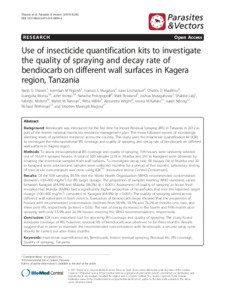Thawer, Narjis G. and Ngondi, Jeremiah M. and Mugalura, Frances E. and Emmanuel, Isaac and Mwalimu, Charles D. and Morou, Evangelia and Vontas, John and Protopopoff, Natacha and Rowland, Mark and Mutagahywa, Joshua and Lalji, Shabbir and Molteni, Fabrizio and Ramsan, Mahdi M. and Willilo, Ritha and Wright, Alexandra and Kafuko, Jessica M. and Ndong, Isaiah and Reithinger, Richard and Magesa, Stephen Masingili.
(2015)
Use of insecticide quantification kits to investigate the quality of spraying and decay rate of bendiocarb on different wall surfaces in Kagera region, Tanzania.
Parasites and Vectors, 8 (242).
![[img]](https://edoc.unibas.ch/style/images/fileicons/application_pdf.png)  Preview |
|
PDF
- Published Version
Available under License CC BY (Attribution).
1962Kb |
Official URL: http://edoc.unibas.ch/dok/A6381867
Downloads: Statistics Overview
Abstract
Bendiocarb was introduced for the first time for Indoor Residual Spraying (IRS) in Tanzania in 2012 as part of the interim national insecticide resistance management plan. This move followed reports of increasingly alarming levels of pyrethroid resistance across the country. This study used the insecticide quantification kit (IQK) to investigate the intra-operational IRS coverage and quality of spraying, and decay rate of bendiocarb on different wall surfaces in Kagera region.; To assess intra-operational IRS coverage and quality of spraying, 104 houses were randomly selected out of 161,414 sprayed houses. A total of 509 samples (218 in Muleba and 291 in Karagwe) were obtained by scraping the insecticide samples from wall surfaces. To investigate decay rate, 66 houses (36 in Muleba and 30 in Karagwe) were selected and samples were collected monthly for a period of five months. Laboratory testing of insecticide concentration was done using IQK(TM) [Innovative Vector Control Consortium].; Of the 509 samples, 89.5% met the World Health Organization (WHO) recommended concentration (between 100-400 mg/m(2)) for IRS target dosage. The proportion of samples meeting WHO standards varied between Karagwe (84.3%) and Muleba (96.3%) (p > 0.001). Assessment of quality of spraying at house level revealed that Muleba (84.8%) had a significantly higher proportion of households that met the expected target dosage (100-400 mg/m(2)) compared to Karagwe (68.9%) (p > 0.001). The quality of spraying varied across different wall substrates in both districts. Evaluation of bendiocarb decay showed that the proportion of houses with recommended concentration declined from 96.9%, 93.5% and 76.2% at months one, two, and three post IRS, respectively (p-trend = 0.03). The rate of decay increased in the fourth and fifth month post spraying with only 55.9% and 26.3% houses meeting the WHO recommendations, respectively. IQK is an important tool for assessing IRS coverage and quality of spraying. The study found adequate coverage of IRS; however, residual life of bendiocarb was observed to be three months. Results suggest that in order to maintain the recommended concentrations with bendiocarb, a second spray cycle should be carried out after three months.
| Faculties and Departments: | 09 Associated Institutions > Swiss Tropical and Public Health Institute (Swiss TPH)
09 Associated Institutions > Swiss Tropical and Public Health Institute (Swiss TPH) > Department of Epidemiology and Public Health (EPH) > Health Interventions > Malaria Interventions (Lengeler) |
|---|
| UniBasel Contributors: | Molteni, Fabrizio |
|---|
| Item Type: | Article, refereed |
|---|
| Article Subtype: | Research Article |
|---|
| Publisher: | BioMed Central |
|---|
| ISSN: | 1756-3305 |
|---|
| Note: | Publication type according to Uni Basel Research Database: Journal article |
|---|
| Language: | English |
|---|
| Identification Number: | |
|---|
| edoc DOI: | |
|---|
| Last Modified: | 15 Nov 2016 15:48 |
|---|
| Deposited On: | 05 Jun 2015 08:53 |
|---|
Repository Staff Only: item control page
